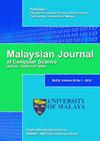REDUCING ENERGY CONSUMPTION IN IOT BY A ROUTING WHALE OPTIMIZATION ALGORITHM
IF 1.1
4区 计算机科学
Q4 COMPUTER SCIENCE, ARTIFICIAL INTELLIGENCE
引用次数: 0
Abstract
The Internet of Things is a new concept in the world of information and communication technology, in which for each being (whether it be a human, an animal or an object), the possibility of sending and receiving data through communication networks such as the Internet or Intranet is provided. Wireless sensors have limited energy resources due to their use of batteries in supplying energy, and since battery replacement in these sensors is not usually feasible, the longevity of wireless sensor networks is limited. Therefore, reducing the energy consumption of the used sensors in IoT networks to increase the network lifetime is one of the crucial challenges and parameters in such networks. In this paper, a routing protocol has been proposed and stimulated which is based on the function of the whale optimization algorithm. Clustering is performed through a routing method which is based on energy level, collision reduction, distance between cluster head node and destination, and neighbor energy. Furthermore, the selection of the cluster head node is performed based on the maximum remaining energy, the least distance with other clusters, and energy consumption, where energy consumption for reaching the base station is minimized. By de-creasing the level of cluster head energy from the specified threshold value from among the nodes in the same cluster, a node with an energy level above the threshold would be selected as the new cluster head. Moreover, four conditions (i.e. the shortest route, the leading route, the least distance to the source node, and destination node) are applied for routing. The proposed method was compared to LEACH, EEUC, EECRP, BEAR and CCR algorithms, and the results indicated the superiority of the proposed method to other methods in terms of the number of dead nodes.通过路由鲸鱼优化算法降低物联网能耗
物联网是信息和通信技术世界中的一个新概念,为每个人(无论是人、动物还是物体)提供了通过互联网或内联网等通信网络发送和接收数据的可能性。无线传感器由于在提供能量时使用电池而具有有限的能量资源,并且由于在这些传感器中更换电池通常是不可行的,因此无线传感器网络的寿命是有限的。因此,降低物联网网络中使用的传感器的能耗以延长网络寿命是此类网络中的关键挑战和参数之一。本文提出并仿真了一种基于whale优化算法的路由协议。聚类是通过一种基于能量水平、冲突减少、簇头节点和目的地之间的距离以及邻居能量的路由方法来执行的。此外,簇头节点的选择是基于最大剩余能量、与其他簇的最小距离和能量消耗来执行的,其中到达基站的能量消耗被最小化。通过从同一簇中的节点中的指定阈值降低簇头能量的水平,将选择能量水平高于阈值的节点作为新的簇头。此外,路由应用了四个条件(即最短路由、领先路由、到源节点的最小距离和目的节点)。将该方法与LEACH、EEUC、EECRP、BEAR和CCR算法进行了比较,结果表明该方法在死节点数量方面优于其他方法。
本文章由计算机程序翻译,如有差异,请以英文原文为准。
求助全文
约1分钟内获得全文
求助全文
来源期刊

Malaysian Journal of Computer Science
COMPUTER SCIENCE, ARTIFICIAL INTELLIGENCE-COMPUTER SCIENCE, THEORY & METHODS
CiteScore
2.20
自引率
33.30%
发文量
35
审稿时长
7.5 months
期刊介绍:
The Malaysian Journal of Computer Science (ISSN 0127-9084) is published four times a year in January, April, July and October by the Faculty of Computer Science and Information Technology, University of Malaya, since 1985. Over the years, the journal has gained popularity and the number of paper submissions has increased steadily. The rigorous reviews from the referees have helped in ensuring that the high standard of the journal is maintained. The objectives are to promote exchange of information and knowledge in research work, new inventions/developments of Computer Science and on the use of Information Technology towards the structuring of an information-rich society and to assist the academic staff from local and foreign universities, business and industrial sectors, government departments and academic institutions on publishing research results and studies in Computer Science and Information Technology through a scholarly publication. The journal is being indexed and abstracted by Clarivate Analytics'' Web of Science and Elsevier''s Scopus
 求助内容:
求助内容: 应助结果提醒方式:
应助结果提醒方式:


